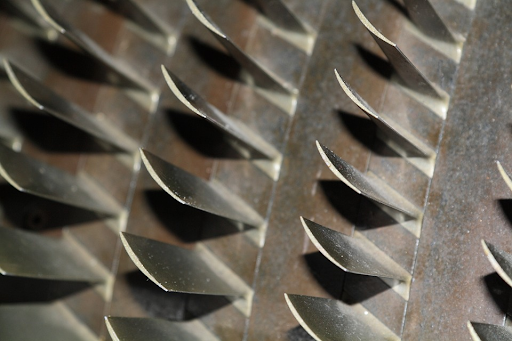The Plasma Thermal Barrier Removal Process Explained
Aerospace and defense manufacturing technologies have seen major advances over the past few decades. So have the techniques used for metal plating and coating of these complex parts. It may seem ironic that, at the same time, very little has changed in the technologies that are used to strip worn or damaged coatings so that the original components can be reworked, cleaned, recoated, and returned to service.
This is only one of many reasons that today’s sophisticated plasma-sprayed thermal barrier coatings are difficult to remove. A closer look at the operational demands on these coatings — and the coating process itself for plasma thermal barriers — can be helpful in understanding the challenges of the removal process.
Why Remove a Plasma Thermal Barrier?
Turbine engines and other aerospace and defense parts regularly undergo maintenance, repair, and overhaul. Thermal Barrier Coating (TBC) failures are a common occurrence on parts such as exhaust muffles of engines and gas turbine blades, which experience extreme forces for long periods of time.
TBCs regularly become spalled, chipped, or eroded from regular use, environmental degradation, and debris in the hot gas path of engines. To maximize the service life of the components, periodic overhauls are necessary where coatings are stripped, components are cleaned, and then recoated with fresh thermal barriers.
What Makes Plasma Coatings So Hard to Remove?
Plasma-spraying techniques create uniquely strong thermal barrier coatings through the application of extreme heat. A plasma torch is able to reach temperatures of 30,000+°F. When the coating material (the “feedstock”) is heated and pushed into the plasma plume, it is shot at the substrate as a jet of high-velocity molten particles that splatter and cool on the surface, adhering and hardening into a coating.
Unlike welding, electroplating, and other deposition processes, where chemical bonds link the atoms in the coating to each other and the underlying surface, plasma spray coating is adhered with mechanical force. This means that the substrate has typically been roughened before applying the coating (to increase adhesion).
Such a coating not only stands up to extreme forces — it took plasma to deposit in the first place — but it is interlocked into the uneven crevices and pits (the “anchor teeth”) of the roughened surface. Since it’s mechanically and not chemically bonded, a chemical solution for removal may be more difficult to find.
How Do You Remove a Plasma Thermal Spray Coating?
There is not one universal solution to plasma thermal barrier removal. The method selected must be specific to the required process for the part, the type of material, and the type of damage to the coating system. Here are a few of the MRO coating removal techniques that may be considered in thermal spray coating removal:
Grit Blasting
Blasting with abrasive media is a mechanical method of removing plasma-sprayed thermal barriers. Great caution is necessary because forcibly propelled grit (a hard particulate material such as silicon carbide, aluminum oxide, or sand) can easily damage the component. It can be difficult to distinguish the coating material from the underlying substrate during the removal process, which can result in uneven removal of plasma coating material and potentially unwanted removal of substrate surface material.
Chemical Stripping
Chemical removal methods involve immersing the component in an aqueous solution that is designed to interact with the plasma coating material. It may contain ferric chloride, nitric acid, phosphoric acid, acid fluoride salts, or other chemicals, as needed. The component is immersed and removed from the bath repeatedly until a sufficient number of repetitions have degraded the coating into a soft residue that can be mechanically removed from the component.
This method is less environmentally friendly than abrasive grit blasting and has to be accompanied by chemical cleaning and manual procedures to scrub or scrape the component — a process not nearly as efficient as grit blasting. It also doesn’t allow for precise control over the roughness of the final surface.
Water Jet Removal
With laser-drilled openings on a stripping nozzle, it’s possible to use high-powered precision water jets to undergo coating removal. The supersonically-propelled water strikes the surface with force in the range of 40,000 to 60,000 PSI. Pressure at this level fractures, spalls, and erodes the coating without damaging the underlying surface. However, this technique is not as widely used and the equipment for it is specialized and expensive.
Laser Ablation
Carbon dioxide (CO2) lasers can remove a ceramic thermal plasma coating with radiation emissions at wavelengths around 9.6 µm and 10.6 µm. The laser removal process enables selective removal, rather than stripping it entirely from the part. This wastes less material. CO2 lasers also don’t interact with metals, which protects the substrate from damage. Laser removal can be painstaking and slow if multiple regions or a large surface area needs to be ablated.
Need Reliable Plasma Spray Coating Removal?
Metal Finishing Technologies is a leading provider of plasma-sprayed thermal coating removal services in the Northeast. Our FAA repair station and dedicated coating stripping area are ready to serve your MRO coating removal needs with high quality and short turnaround times.
We approach all plasma coating removal projects with efficiency, speed, competitive pricing, and the chance to provide sample parts and test our results beforehand. If you are looking for world-class plasma thermal barrier removal, request a quote today!

